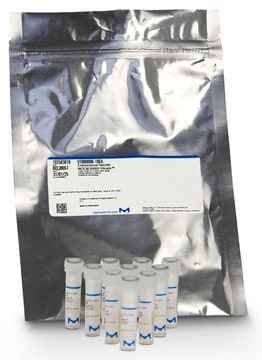CRM11994M
Listeria monocytogenes NCTC 11994 Lenticule® discs
500-50000 CFU, suitable for microbiology, certified reference material, Manufactured by: Sigma-Aldrich Production GmbH, Switzerland
Synonym(s):
Microbiological standards, Certified reference material, Listeria NCTC 11994 Lenticule® discs
About This Item
Recommended Products
grade
certified reference material
Quality Level
Agency
ISO 17034
ISO/IEC 17025
form
disc (hydrosoluble)
solid
shelf life
limited shelf life, expiry date on the label
packaging
package of 10 discs
manufacturer/tradename
Manufactured by: Sigma-Aldrich Production GmbH, Switzerland
impurities
500-50000 CFU
application(s)
environmental
food and beverages
microbiology
storage temp.
−20°C
suitability
Listeria monocytogenes
Listeria spp.
Looking for similar products? Visit Product Comparison Guide
General description
The technology allows long-term conservation and renders the organisms resistant to temperature changes. They are intended to be used as daily internal quality control organisms. These microorganisms are certified according to ISO/IEC 17025 and produced under reproducible conditions compliant with ISO 17034 using authenticated strains from NCTC.
These ready-to-use microbiological controls minimize the need for maintaining control strains in the test laboratory and guarantee the use of an authenticated control culture for every quality control test.
Lenticule® discs are prepared from a traceable culture obtained freeze-dried from the National Collection of Type Cultures (NCTC) or National Collection of Pathogenic Fungi (NCPF). They are manufactured by Sigma-Aldrich under license from UK Health Security Agency.
Application
Features and Benefits
- Ready-to-use at convenient CFU ranges
- No dilution required
- Quick rehydration in 10 minutes
- At least 16 months of shelf life in a standard -20 °C freezer
- Complete with a comprehensive certificate of analysis
- No maintenance of stock cultures
- No recovery time or pre-enrichment step is necessary
- Robust, efficient, and reliable
- Easy-to-use
- Cost-effective
Other Notes
Other cell culture collections:
- DSM 15675
- CECT® 4032
Legal Information
Storage Class Code
11 - Combustible Solids
WGK
WGK 3
Choose from one of the most recent versions:
Already Own This Product?
Find documentation for the products that you have recently purchased in the Document Library.
Customers Also Viewed
Our team of scientists has experience in all areas of research including Life Science, Material Science, Chemical Synthesis, Chromatography, Analytical and many others.
Contact Technical Service
